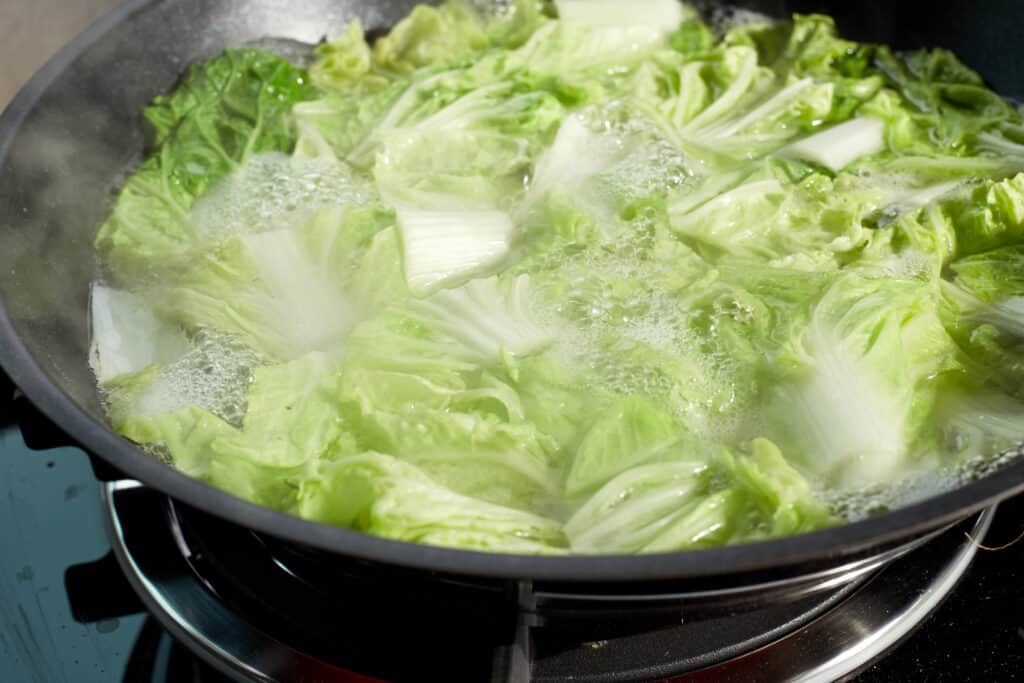Pei tsai can be eaten raw or steamed, boiled, or quickly stir-fried. Pei tsai refers to several small, loose-leafed Chinese cabbages.
Pei tsai is loose-headed cabbage with long, narrow, textured leaves whose tips branch outwards. It grows to about 12 inches (30 cm) tall.

The light green, ruffled leaves and prominent white stalks are tender with a tangy-sweet, but not spicy flavor. The interior of pei tsai is creamy yellow.
How to choose pei tsai
- Select pei tsai that is compact, firm, crisp, and fresh. There should be no brown spots on the ribs.
- Avoid greens whose leaves are slightly wilted or exhibit brown spots.
How to store pei tsai
- Pei tsai is best used fresh but it can be stored for a few days if refrigerated.
How to prep pei tsai
- Wash pei tsai just before using it.
- Remove the desired number of leaves and trim the base of each, wash, drain, and use cooked or raw.
Pei tsai serving suggestions
- Pei tsai can be steamed, boiled, quickly stir-fried, or eaten raw.
- Both the leaves and stalks of pei tsai are excellent for stir-fry.
- Cooked leaves and stalks add flavor to soups, stews, pasta dishes, and stir-fries.

How to steam pei tsai
- Add a few inches of water to a pot then insert a steamer basket. The water should not touch the bottom of the steamer basket.
- Bring the water to a simmer over medium-high heat.
- Add whole or shredded leaves and cover.
- Steam until tender, about 4 or 5 minutes.
How to boil pei tsai
- Shred or cut head in halves or quarters.
- Bring a lightly salted pot of water to a boil.
- Put pei tsai in the pot and boil for about 3 to 5 minutes for shredded leaves, about 10 minutes for halves and quarters.
- Remove the pei tsai with a slotted spoon and dry on a kitchen towel or a paper-towel-lined plate.
How to stir-fry pei tsai
- Tear or shred leaves.
- Heat 2 tablespoons of vegetable oil in a wok.
- Add the leaves and 2 sliced garlic cloves.
- Stir-fry until the leaves start to wilt then add a quarter cup or slightly more vegetable stock.
- Cover and cook for 3 minutes or until just tender.
How to sauté pei tsai
- Place a tablespoon of oil in a large skillet and place over medium-high heat.
- Add thinly sliced, shredded, or small whole leaves and season with soy sauce or salt and pepper.
- Cook, stirring often, until the leaves are tender, about 10 minutes.

More about pei tsai
- Pei tsai is very popular in Japan and Taiwan. The best-known varieties are ‘Ruffles’, ‘Shantung’, ‘Minato Santo’, and ‘Santo’.
- The water content of these Asian cabbages is higher than that of the European varieties of cabbage. They are crisper and more refreshing and also less fibrous.
- The flavor of Asian cabbage is more subtle and pleasant than European head cabbage.
- Pei tsai is perfect for cut-and-come-again harvests.
Pei tsai belongs to the pekinensis subspecies of the Brassica genus.
Related article:
Five Ways to Cook and Serve Bok Choy
Seven Ways to Cook and Serve Chinese Cabbage
Articles of interest:
Best Herbs for Container Growing
Garden Planning Books at Amazon:
- Vegetable Garden Almanac & Planner
- Kitchen Garden Grower’s Guide Vegetable Encyclopedia
- Vegetable Garden Grower’s Guide
- Tomato Grower’s Answer Book
More kitchen tips:
Bring your harvest to the table. Kitchen prep tips and easy recipes for the vegetables you grow. Click below for vegetable prep and recipes you can use now.
- Almonds
- Apples
- Apricot
- Aprium
- Artichoke
- Arugula
- Asparagus
- Avocado
- Bamboo Shoots
- Banana
- Basil
- Beans, Dried
- Beans. Long
- Beans, Shell
- Beans, Snap
- Beets
- Bitter Melon
- Blackberry
- Bok Choy
- Broccoli
- Broccoli Raab
- Brussels Sprouts
- Cabbage
- Cardoon
- Carrots
- Cauliflower
- Celeriac
- Celery
- Chard
- Chayote Squash
- Cherimoya
- Cherries
- Chestnut
- Chickpea
- Chinese Cabbage
- Chives
- Cilantro
- Citron
- Clementine
- Collards
- Coriander
- Corn, Sweet
- Corn, Baby
- Corn Salad, Mache
- Cranberry
- Cress
- Cucumber
- Daikon
- Dandelion
- Dill
- Eggplant
- Endive, Belgian
- Endive and Escarole
- Fava Beans
- Fig
- Florence Fennel
- Garlic
- Ginger
- Grapefruit
- Grapes
- Guava
- Horseradish
- Jerusalem Artichoke
- Jicama
- Jujube
- Kale
- Kiwifruit
- Kohlrabi
- Kumquat
- Leeks
- Lemongrass
- Lemons
- Lettuce
- Lime
- Mache (Corn Salad)
- Mandarin Orange
- Mango
- Maple Syrup
- Marjoram
- Melons
- Michihili
- Mint
- Mizuna
- Mushrooms
- Mushrooms, Cremini
- Mustard Greens
- Napa Cabbage
- Nectarine
- Okra
- Olives
- Olive oil
- Onions
- Oranges
- Oregano
- Parsley
- Parsley Root
- Parsnips
- Passion Fruit
- Pawpaw
- Peaches
- Pears
- Peas, Garden Snap
- Peas, Snow
- Pei Tsai
- Peppers, Chili
- Peppers, Sweet
- Persimmon
- Pineapple
- Pineapple Guava
- Plantain
- Plums
- Pluots
- Pomegranate
- Potatoes
- Prickly Pear
- Pumpkin
- Quince
- Radicchio
- Radishes
- Raspberries
- Rosemary
- Rhubarb
- Rutabaga
- Sage
- Salsify
- Sauerkraut
- Savory
- Shallots
- Sorrel
- Spinach
- Squash, Summer
- Squash, Winter
- Strawberries
- Sunchokes
- Sunflower
- Sweet Potato
- Swiss Chard
- Tangerine
- Taro
- Tarragon
- Thyme
- Tomatillo
- Tomato
- Turnip
- Turnip Greens
- Yams



